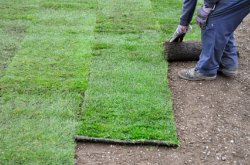How to Install a Sod Lawn
 We covered how to seed a lawn in a previous post. In this post, we will review the steps on how to install a sod lawn. One of the big advantages of installing new sod is that you immediately have a green lawn. There are a number of steps required to ensure that your lawn stays healthy and looks green the whole season. You don’t want to spend all of that money on a new lawn, particularly a sod lawn and then have it turn brown because you didn’t install it properly or look after it after the sod was laid down. The following are the steps that one should follow to ensure a great-looking lawn.
We covered how to seed a lawn in a previous post. In this post, we will review the steps on how to install a sod lawn. One of the big advantages of installing new sod is that you immediately have a green lawn. There are a number of steps required to ensure that your lawn stays healthy and looks green the whole season. You don’t want to spend all of that money on a new lawn, particularly a sod lawn and then have it turn brown because you didn’t install it properly or look after it after the sod was laid down. The following are the steps that one should follow to ensure a great-looking lawn.
Steps – How to Install a Sod Lawn
- Choose high-quality sod – if the sod already has brown spots or looks dried out, chances are it will not look very good or grow properly once installed.
- Prepare the soil – make sure there is at least 3 inches of high-quality topsoil that is evenly spread across the area where you’re going to install the sod. There should be no gullies or high points and you want to pack the soil lightly before laying the sod. Use a wide rake to level the ground and prepare it for the new sod.
- Spread fertilizer and moisten soil – spread fertilizer evenly across the ground, avoid concentrations of fertilizer to avoid burning the new sod. Dampen the soil before laying the sod to provide a nice moist environment for the roots of the new grass.
- Keep sod moist – once the side arrives at your home keep it moist and lay it as soon as possible. If it must sit in the hot sun for any time, spray the sod with water. You want to keep the sod from drying out.
Laying the Sod
- Start with a straight edge – always start along the straight edge of your yard. A concrete driveway makes an excellent straight edge or the side of your house for example.
- Roll out the sod – One at a time taking care to maintain the straight edge that we mentioned earlier.
- Place edges tightly together – wherever one piece of sod touches another. This will ensure that there are no small holes or areas that lack grass.
- Cut pieces to fit – small areas and where you must fit in a small section of sod. e.g. along the fence, around shrubs, or trees.
- Roll to ensure contact – use a water-filled rolling drum across your lawn. This will ensure that the sod is in contact with the moist soil underneath and to level out any rough edges.
- Water thoroughly – lack of water on the new sod during hot weather is most often the cause for the sod to dry up and die. For the first two weeks make sure that your new sod has lots of water so that the roots can establish themselves in the topsail underneath the sod.
You can follow any responses to this entry through the RSS 2.0 feed. You can leave a response, or trackback from your own site.


Leave a Reply